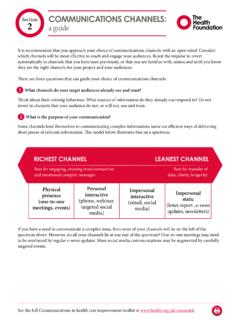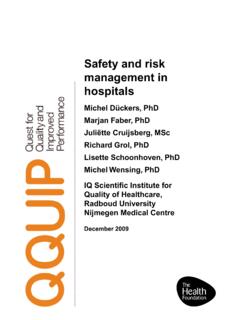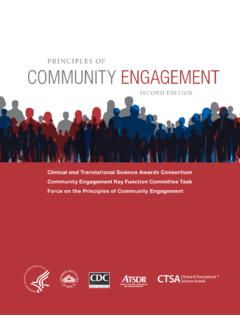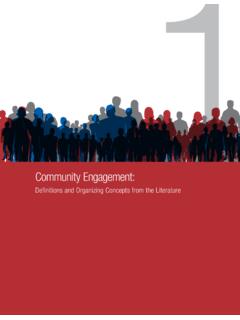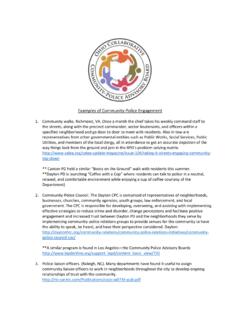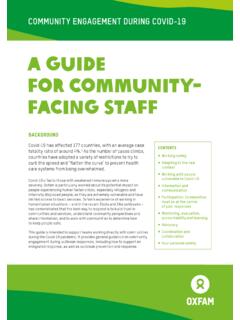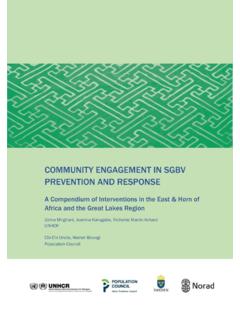Transcription of Community engagement report - Health Foundation
1 Community engagement reportfor the Health FoundationProduced as a scoping paper for the Health Foundation in 2009. Michael Blomfield and Harry CaytonIdentify Innovate Demonstrate Encourage2 The Health FoundationCommunity engagement report 3 Introduction 4 Definitions 4 engagement 4 Evaluation and Evidence 5 Obstacles to engagement and costs of disengagement 7 Why many efforts to engage the public have failed 13 Historical background to Community engagement initiatives 13 Approach to Community and engagement 15 Not engaging with authentic communities 15 Targeting social norms and identifying appropriate 17 communities for engagement Large-scale comprehensive interventions 19 Length of intervention 20 Mobilising communities for Health 21 Risk and flexibility in commissioning 22 Strategies and interventions for change 23 Barriers to the take-up of Health services by communities 29 General barriers to the take-up of Health services 30 Community engagement in maternity services in
2 Developing countries 32 Interventions for maternal Health in developed countries 34 Recommendations 39 Background information 41 References 42 Contents4 The Health FoundationCommunity engagement report 5 EngagementThe term engagement also, presents some difficulties. Consultation alone cannot be described as engagement and is therefore mostly excluded from our review. engagement must, minimally, involve people and communities throughout the activity to ensure their preferences, interests, concerns and aspirations are determining the outcome. engagement can also go beyond this to be fully collaborative with communities, partnering with them on all aspects of decisions including identifying solutions and developing alternatives. Ultimately communities can be fully empowered by having the final decision and resources within their control. This, we assume, is the objective of Community quality of evidence for effective Community engagement is variable.
3 We have identified a large number of papers, many from grey literature. Often these are write-ups and reports rather than proper evaluations and it is rare for there to be controlled trials of any sort. This is more a failure of research methodology than a failure of intent. For instance, Community engagement does not easily lend itself to randomised trials because the intervention is with a targeted Community . Also, with very limited resources often coming from the Community itself, evaluation may be inappropriate or unethical. 1 IntroductionDefinitionsThere are different approaches to defining Community . In many Community engagement projects there are geographically defined communities, which may cover a few streets or an entire city, or communities of interest where the members share particular characteristics or concerns. Community can also be either self-defined or defined by researchers for the purpose of their project.
4 This means there are many approaches to both the Community and engagement aspects for the purpose of Community engagement initiatives in Health and it is not possible to assume that either word has a precise reviewed studies suggest that it would be useful to engage communities of interest within a particular area in which people come together in shared patterns of interaction. These communities are most likely to contain members who self-identify with each other, either as a Community or more simply just as a social group. That they share strong levels of social interaction means that engagement initiatives can work to affect behavioural factors in their lives, social networks and norms that may be reinforcing unhealthy behaviour. Addressing the social aspect of their lives makes mobilising for, and owning, Health a social norm. Communities that cannot be engaged in such a way may be difficult to work with for the purpose of mobilising for, and taking ownership of, are considerable methodological difficulties in both the design and outcomes of evaluations of complex social interventions.
5 The Health Foundation will be familiar with the debate between quantitative randomised controlled trial approaches to large-scale interventions, which inevitably aim to eliminate the noise of variables, and qualitative approaches, which by aiming to include real life variables, are consequently limited in power and statistical this difficulty is presented as a failure of evidence. Actually it is a failure of research methodology to analyse and resolve multi- factorial methodological deficit does distort research evidence and it is important to take this into account when evaluating. To use the terms of the dominant research paradigm there may be both false positives and false negatives in the data as reported. As we suggest later, the Foundation will need to take this into account if designing an evaluation of any complex multi-factorial intervention which it might promote in the area of Community involvement.
6 In doing so it would be breaking new ground and might make a significant contribution to research methodology thought and effort needs to be put into qualitative and quantitative approaches to evaluating Community engagement and particularly into user-defined outcome were asked in this report to pay particular attention to prenatal and perinatal maternity services. Where there are specific examples we include these in the text. There is little available information about barriers to adoption of maternity services in developed countries and on how Community engagement could be used. There is, however, some information from developing counties where Community engagement methods have been used of the issues in developing counties, such as poor sanitation and physical access to hospitals or midwives, are not particularly relevant but what is successful and what works in terms of ways of engaging with people is common across all approaching this report to the Health Foundation (the Foundation ) we have encountered a number of problems of scope, definition and evidence.
7 We think it helpful to set these out at the beginning to provide context to our and evidence6 The Health FoundationCommunity engagement report 7A study carried out by the King s Fund in 2004 shows that there is a widespread belief that people should take responsibility for their own Health , but that there is strong variation by social class as to whether people are sufficiently in control of their own Health to be held responsible for it. The study found that 88% of people agree that individuals are responsible for their own Health . More than 40%, however, agreed that there are too many factors outside individual control to hold people responsible for their own wellbeing. This figure was 54% among those in the DE socioeconomic class but only 31% among the AB suggests that those in higher socioeconomic classes feel more in control and empowered to take active responsibility and ownership for their Health .
8 The results of a 2005 Department of Health study2 into public attitudes to self-care and self-care behaviours demonstrate how differences in socioeconomic status correspond with differences in Health status. The amount of self-care undertaken by those suffering from long-term conditions and the limitations on their lives caused by their condition were also study published the following results on reported Health among the general public (percentages of each socioeconomic class reporting Health on the whole good on the whole fair/poor). Interestingly, there was little difference by 18C176 24C273 27DE65 35 This shows that those in higher socioeconomic classes those that tend to feel better able to take ownership over their own Health report higher Health status. Although the correlation does not imply causation it is worth noting and makes it an interesting hypothesis as to whether increasing self-perceived control and ownership of Health would increase self-reported Health Obstacles to engagement and costs of disengagementIn order to identify the purposes of, and most appropriate ways to, engage communities in the personal Health issues of their members, it is important to identify the more general obstacles to engaging people in their Health .
9 Similarly, it is useful to identify the costs to Health that are associated with this disengagement. 8 The Health FoundationCommunity engagement report 9 Among those with long-term conditions the percentages responding yes no as to whether their condition limited their activities in any way are shown below:AB34 65C140 60C240 60DE55 44 Similarly, among those with long-term conditions, there is a strong correlation between an individual s socioeconomic class and whether or not their activities are limited by their condition. It is interesting to note this correlation between self-perceived control and ownership of Health and the impact a condition can have on daily study noted that its findings suggest that people who do more self-care feel that their Health is good, very good or excellent while those who do less feel that their Health is poor or fair. This suggests a link between ownership of Health (to the extent undertaking self-care serves as a proxy measure for this) and self-reported Health status among those with long-term who say their Health is fair or poor, who tend to be more disadvantaged and more elderly, are less likely to be active self-carers compared to those who say their Health is good, very good or excellent.
10 Those from lower socioeconomic groups and those with the poorest Health are therefore those who require more specific attention to promote self-care and healthy lifestyles. Interestingly, the study also found that those who lived in the most deprived wards are more likely to agree that support from people with similar Health problems, experiences, concerns and conditions would give them confidence to do self-care. This suggests that greater support from those with a similar life to them who they can better relate to would help them take more ownership of their Health (again to the extent undertaking self-care among those with long-term conditions is a proxy measure for this).The Patient Activation Measure (PAM), developed in the USA by Judy Hibbard, is a mechanism for measuring the skills, knowledge, beliefs, and motivations people need to become activated or more effectual healthcare Activation has four levels: (1) believing the patient role is important; (2) having the confidence and knowledge necessary to take action; (3) actually taking action to maintain and improve one s Health ; and (4) staying the course even under stress.




